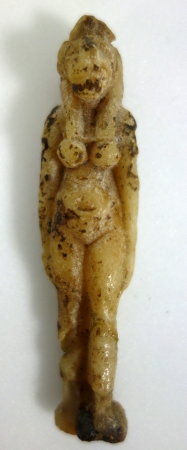Online Collections at UoB - Objects
ID number: ECM 638
Named collection: The Eton Myers Collection
Title / Object name: Beeswax Sekhmet or Mut Figurine
Object type: Figurine
Culture: Egyptian
Date made: Late Period (ca. 664-332 BCE)
Collector: Myers, William Joseph
Materials: Beeswax
Measurements: overall: 11.80 cm x 2.90 cm x 2.50 cm (H x W x D)
Provenance: Unknown
|

|
Standing figure of the lioness headed deity Sekhmet (or Mut), naked, with her hands down by her sides. She has a striated tripartite wig, with the remains of a solar disc and uraeus on her head. The figurine has a dorsal pillar for stability. The front part of the feet are broken away.
Bibliography: For more information about the use of beeswax in ancient Egypt, see
Z. Shoosmith 2016 'Life Through Wax: Beeswax in ancient Egypt' in S. Boonstra (ed.) Objects Come to Life Virtual Exhibition, Birmingham Egyptology.
Notes: Originally separate goddesses, by the New Kingdom (ca. 1550-1069 BCE) Sekhmet came to be considered as an aspect of Mut. Sekhmet was associated with plague and was thought to be capable of both causing and preventing diseases. By representing Sekhmet, this figurine could have served as amuletic protection against illnesses for which she was responsible.
Beeswax in ancient Egypt was associated with life. It was easy to sculpt, allowing an individual to mimic the god Khnum, who made life on a potter's wheel. Beeswax was also associated with the solar god Re whose tears were said to have turned into the first bees. The life-giving symbolism of beeswax made it useful to help the dead into the afterlife. Amulets such as scarabs and ankhs were sometimes made of wax. Mummy portraits could also be given life-like textures with beeswax and metal sculptures could be made more detailed through 'lost wax casting'. Models made with wax could be used when vitality was needed either to help or harm a person. Destroying a model enemy was seen to destroy the threat of an actual enemy. A wax model could also encourage healing or aid rebirth into the afterlife. Consequently wax models could be used in a wide range of circumstances and were common in Egyptian society.
|
3 Related Media Items
| << Viewing Record 13 of 543 >> |